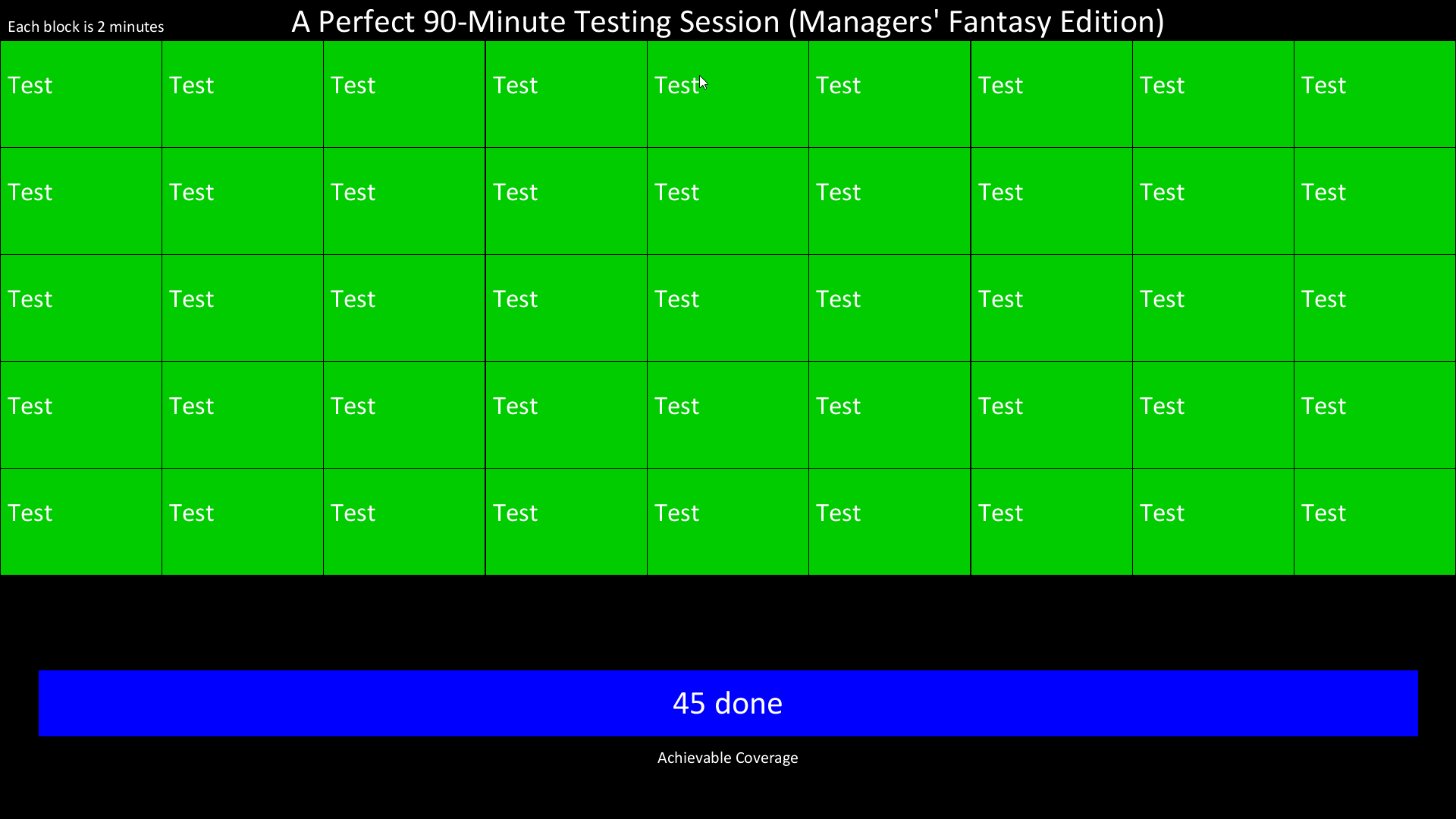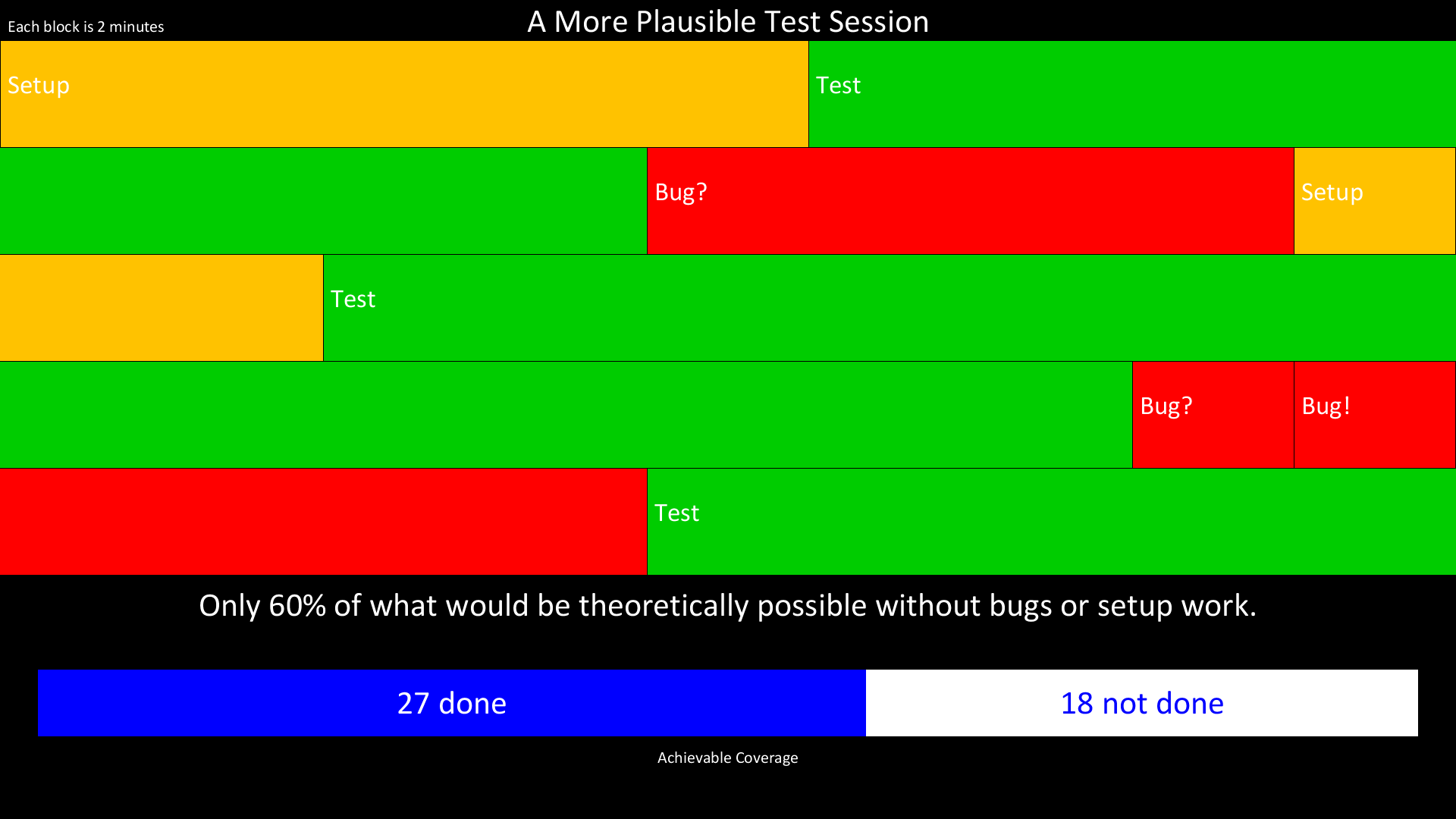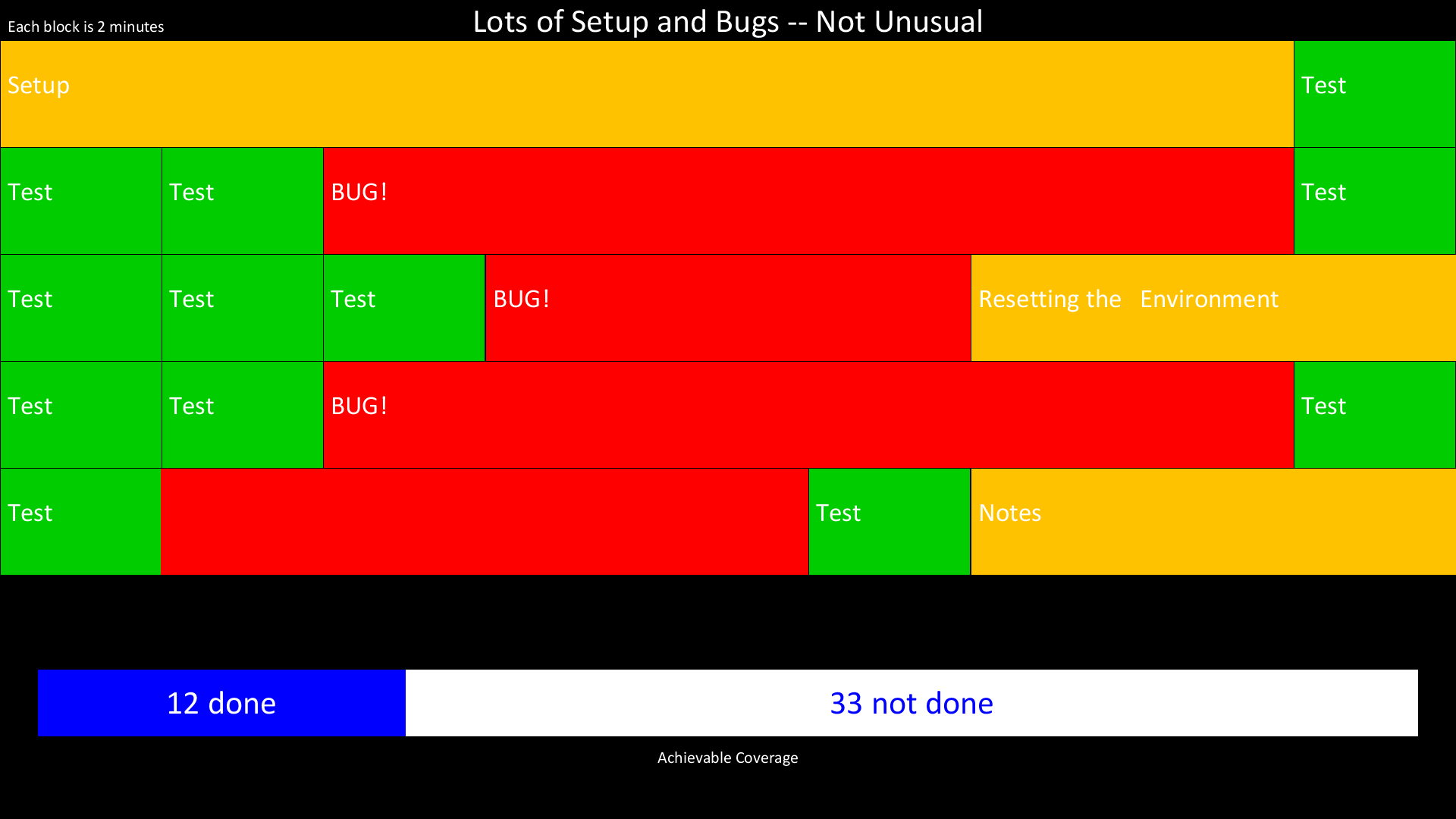Throughout this series, we’ve been looking at an an alternative to artifact-based approaches to performing and accounting for testing: an activity-based approach.
Frieda, my coaching client, and I had been discussing how to manage testing without dependence on formalized, scripted, procedural test cases. Part of any approach to making work accountable is communication between a manager or test lead and the person who had done the work. In session-based test management, one part of this communication is a conversation that we call a debrief, and that’s what we talked about last time.
One of the important elements of a debrief is accounting for the time spent on the work. And that’s why one of the most important questions in the debrief is What did you spend your time doing in this session?
“Ummm… That would be ‘testing’, presumably, wouldn’t it?” Frieda asked.
“Well,” I replied, “there’s testing, and then there’s other work that happens in the session. And there are pretty much inevitably interruptions of some kind.”
“For sure,” Frieda agreed. “I’m getting interrupted every day, all the time: instant messages, phone calls, other testers asking me for help, programmers claiming they can’t reproduce the bug on their machines…”
“Interruptions are a Thing, for sure,” I said. “Let’s talk about those in a bit. First, though, let’s consider what you’d be doing during a testing session in which you weren’t interrupted. Or if we didn’t talk about the interruptions, for a moment. What would you be doing?”
“Testing. Performing tests. Looking for bugs,” said Frieda.
“Right. Can you go deeper? More specific?”
“OK. I’d be learning about the product, exercising test conditions, increasing test coverage. I’d be keeping notes. If I were making a mind map, I’d be adding to it, filling in the empty areas where I hadn’t been before. Each bit of testing I performed would add to coverage.”
“‘Each bit of testing,'”, I repeated. “All right; let’s imagine that you set up a 90-minute session where you could be uninterrupted. Lock the office door…”
“…the one that I don’t have…”, Frieda said.
“Natch. It’s cubicle-land where you work. But let’s say you put up a sign that said “Do not disturb! Testing is in Session!” Set the phone to Send Calls, shut off Slack and Skype and iMessage and what-all… In that session, let’s just say that you could do a bunch of two-minute tests, and with each one of those tests, you could learn something specific about the product.”
“That’s not how testing really works! That sounds like… test cases!” Frieda said.
“I know,” I grinned. “You’re right. I agree. But let’s suspend that objection for a bit while we work through this. Imagine that 90-minute session rendered as a nine-by-five table of 45 little microbursts of test activity. The kind of manager that you’ve been role-playing here thinks this will happen.”

Frieda chuckled. “Manager’s Fantasy Edition. That’s about right.”
“Indeed,” I said. “But why?”
“Well, obviously, when I’m testing, I find bugs. When I do, start investigating. I start figuring out how to reproduce the bug, so I can write it up. And then I write it up.”
“Right,” I said. “But even though it’s part of testing, it’s got a different flavour than the learning-focused stuff, doesn’t it?”
“Definitely,” said Frieda. ” When I find a bug, I’m not covering new territory. It’s like I’m not adding to the map I’m making of the product. It’s more like I’m staying in the same place for a while while I investigate.”
“Is that a good thing to do?”
“Well…, yes,” Frieda replied. “Obviously. Investigating bugs is a big part of my job.”
“Right. And it takes time. How much?”
“Well,” Frieda began, “A lot of the time I repeat the test to make sure I’m really seeing a bug. Then I try to find out how to reproduce it reliably, in some minimum set of steps, or with some particular data. Sometimes I try some variations to see if I can find other problems around that problem. Then I’ve got to turn all that into a bug report, and log it in the tracking system. Even if I don’t write it up formally, I have to talk to the developer about it.”
“So, quite a bit of time,” I said.
“Yep,” she said. “And another thing: some bugs block me and prevent me from getting to part of the product I want to test. Trying to work around the blockers takes time too. So… like I said, while I’m doing all those things, I’m not covering new ground. It’s like being stuck in the mud on a flooded road.”
“If I were your manager, and if I were concerned about your productivity, I’d want to know about stuff like that,” I said. That’s why, in session-based test management, we keep track of several kinds of testing time. Let’s start with two: test design and execution, in which we’re performing tests, learning about the product, gaining a better understanding of it. Of course, our focus is on activity that will either find a bug, or help us to find a bug. We call that T-time, for short, and distinguish it from bug investigation and reporting—B-time—which includes the stuff that you were just talking about. The key thing is that B-time interrupts T-time.”
Frieda’s brow furrowed. “Or, to put it another way, investigating bugs reduces test coverage.”
“Yes. And when it does, it’s important for managers to know about it. As a manager, I don’t want to be fooled about coverage—that is, how much of the product that we’ve examined with respect to some model.
“You start a session with a charter that’s intended to cover something we want to know about. In a 90-minute session, it’s one thing if a tester spends 80 minutes covering some product area with testing and only ten minutes investigating bugs. It’s a completely different thing if the tester spends 80 minutes investigating bugs, and only ten minutes on tests that produced new coverage. If you only spend ten percent of the time addressing the charter, and the rest on investigating a bug that you’ve found, I’d hope you’d report that you hadn’t accomplished your charter.”
“Wait… what if I were nervous about that?” Frieda asked. “Doesn’t it look bad if I haven’t achieved the goal for the session?”
“Not necessarily,” I replied. “We can have the best of intentions and aspirations for a session before it starts But the product is what it is, and whatever happens, happens. Whatever the charter suggests, there’s an overarching mission for every session: investigate the product and report on the problems in it. If you’re having to report lots of bugs because they’re there, and you’re doing it efficiently, that shouldn’t be held against you. Testers don’t put the bugs in. If there are problems to report, that takes time, and that’s going to reduce coverage time. If you’re finding and investigate a lot of bugs, there’s no shame in not covering what we might hope you’d cover. Plus, bug investigation helps the developers to understand what they’re dealing with, so that’s a service to the team.”
Frieda looked concerned. “Not very managers I’ve worked with would understand that. They’d just say, ‘Finish the test cases!’ and be done with it.”
“That can be an issue, for sure. But a key part of testing work these days is to help managers to learn how to become good clients for testing. That sometimes means spelling out certain things explicitly. For instance: if you find a ton of bugs in during in a session, that’s bad enough, in that you’ve got a lot less than a session’s worth of test coverage. But there’s something that might be even worse on top of that: you have found only the shallowest bugs By definition; the bugs you’ve found already were the easiest bugs to find. A swarm of shallow bugs is often associated with an infestation of deeper bugs.”
“So, in that situation, I’m going to need a few more sessions to obtain the coverage we intended to achieve with the first one,” said Frieda.
“Right. And you if you’re concerned about risk, you’ll may want to charter more, deeper testing sessions, because—again, by definition—deeper bugs are harder to find.”
Frieda paused. “You said there were several kinds of testing time. You mentioned T-time and B-time. That’s only two.”
“Yes. At very least, there’s also Setup time, S-time. While you’re setting up for a test, you aren’t obtaining coverage, and you’re not investigating or reporting a bug. Actually, setting up is only one thing covered our notion of “Setup”. S-time is a kind of catch-all for time within the session in which you couldn’t have found a bug. Maybe you’re configuring the product or some tool; maybe you’re resetting the system after a problem; maybe you’re tidying up your notes.”
“Or reading about the product? Or talking with somebody about it?”, Frieda asked.
“Right. Anything that’s necessary to get the work done, but that isn’t T-time or B-time. So instead of that Manager’s Fantasy Version of the session, a real session often looks like this:”

“Or even this.”

“Wow,” said Frieda. “I mean, that second one is totally realistic to me. And look at how little gets covered, and how much doesn’t get covered.”
“Yeah. When we visualize like this, makes an impression, doesn’t it? Trouble is, not very many testers help managers connect those dots. As you said, if you want to achieve the coverage that the manager hoped for in the Fantasy Edition, this helps to show that you’ll need something like four sessions to get it, not just one. Plus the bugs that you’ve found in that one session are by definition the shallowest bugs, the ones closest to the surface. Hidden, rare, subtle, intermittent, emergent bugs… they’re deeper.”
Frieda still had a few more questions, which we’ll get to in the next installment in this series — available by clicking here, rather than below.
[…] Breaking the Test Case Addiction (Part 8) – Michael Bolton – https://www.developsense.com/blog/2019/12/breaking-the-test-case-addiction-part-8/ […]
[…] Breaking the Test Case Addiction (Part 8) Written by: Michael Bolton […]
[…] Michael Bolton’s “Breaking The Test Case Addiction” blog series, e.g. https://www.developsense.com/blog/2019/12/breaking-the-test-case-addiction-part-8/ […]
[…] examples here: https://www.developsense.com/blog/2012/10/where-does-all-that-time-go/ and here https://www.developsense.com/blog/2019/12/breaking-the-test-case-addiction-part-8/) Then ask “Is everyone okay with this?” If they are, then don’t worry. If they’re […]